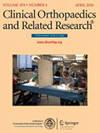How Do Gunshot and Explosive Injuries to the Lower Extremities Differ in Severity and Treatment? A Comparative Study From the Israel-Gaza Conflict.
IF 4.2
2区 医学
Q1 ORTHOPEDICS
引用次数: 0
Abstract
BACKGROUND Lower extremity injuries are common in conflict-related trauma, with gunshot wounds (GSWs) causing localized damage and explosive trauma leading to extensive tissue injuries. Existing research lacks direct comparisons of injury severity and treatment outcomes between GSWs and explosive trauma in modern conflicts. This study clarifies these differences to improve triage strategies, surgical planning, and rehabilitation protocols. QUESTIONS/PURPOSES (1) How did GSWs and explosive trauma differ in terms of injury severity, including the proportion of patients in each group who experienced open fractures, neurovascular injuries, and amputations, during the Israel-Gaza conflict? (2) What was the comparative frequency and type of surgical intervention performed for GSWs versus explosive trauma in lower extremities? METHODS Between October 7, 2023, and December 31, 2023, a total of 1815 patients were entered into the Israel National Trauma Registry (INTR) as having been injured during the Israel-Gaza conflict. The INTR is a comprehensive national database that collects standardized injury and treatment information from all Level 1 and Level 2 trauma centers in Israel, ensuring high-quality, consistent reporting of war-related injuries. Of these, we considered patients with lower extremity injuries and ICD-9 E-codes E979 and E990-E999 (terror and war-related injuries) as potentially eligible. Based on this criterion, 1318 patients sustained extremity injuries, and 51% (674) met our inclusion criteria for this study. Among them, 53% (357 of 674) sustained GSWs and 47% (317) suffered explosive injuries. The groups did not differ in terms of mean ± SD ages (gunshot 28.5 ± 11.7 years, explosive 28.0 ± 11.4 years; p = 0.61). Most patients in both groups were men (gunshot 91%, explosive 95%; p = 0.09), with no between-group difference in terms of the proportion of patients who were men. Missing data were minimal in both groups, with complete data sets available for all primary outcomes. Comparisons were made between the two groups regarding the severity of injuries (such as open fractures and amputations), frequency and type of surgical interventions, and associated injuries (including those to the chest, abdomen, and face). Statistical analysis included chi-square tests for categorical variables and independent t-tests for continuous variables, with a significance threshold of p < 0.01 because of the large number of comparisons made. RESULTS GSWs resulted in a higher proportion of patients with open fractures (32% [115 of 357] versus 20% [64 of 317]; p = 0.001), particularly in the tibia and fibula (17% [62 of 357] versus 10% [33 of 317]; p = 0.01), whereas explosive injuries led to more amputations (10% [31 of 317] versus 3% [11 of 357]; p < 0.001); neurovascular injuries did not differ (p = 0.14 for nerve and p = 0.54 for vascular). A higher proportion of gunshot injuries were treated surgically (73% versus 59%; p < 0.001). CONCLUSION Understanding the distinct injury patterns and outcomes of GSWs and explosive trauma is essential for improving patient care and resource allocation during conflicts. Given the high amputation rates in blast injuries, early rehabilitation and prosthetic support should be prioritized, while gunshot-related open fractures often call for expanded orthopaedic fixation and infection control. Trauma training should emphasize early surgery for GSWs and hemorrhage control for blast injuries. Future research should focus on long-term functional outcomes, protective gear efficacy, and improved battlefield evacuation strategies to enhance survivability and recovery. LEVEL OF EVIDENCE Level III, therapeutic study.下肢枪伤和爆炸伤在严重程度和治疗上有何不同?以色列-加沙冲突的比较研究。
背景:下肢损伤在与冲突有关的创伤中很常见,枪伤(GSWs)造成局部损伤,爆炸性创伤导致广泛的组织损伤。现有研究缺乏对现代冲突中GSWs和爆炸性创伤的损伤严重程度和治疗结果的直接比较。问题/目的(1)在以色列-加沙冲突期间,GSWs和爆炸性创伤在损伤严重程度方面有何不同,包括每组患者经历开放性骨折、神经血管损伤和截肢的比例?(2)下肢GSWs与爆炸性创伤的手术干预频率和类型比较?方法:在2023年10月7日至2023年12月31日期间,共有1815名在以色列-加沙冲突期间受伤的患者进入以色列国家创伤登记处(INTR)。INTR是一个综合性的国家数据库,从以色列所有一级和二级创伤中心收集标准化的伤害和治疗信息,确保高质量、一致的战争相关伤害报告。其中,我们认为下肢损伤和ICD-9 e代码E979和E990-E999(恐怖和战争相关损伤)的患者可能符合条件。根据这一标准,1318例患者发生肢体损伤,其中51%(674例)符合本研究的纳入标准。674例中,53%(357例)为GSWs, 47%(317例)为爆炸伤。两组在平均±SD年龄方面无差异(枪击28.5±11.7岁,爆炸28.0±11.4岁;P = 0.61)。两组患者均以男性居多(枪击91%,爆炸95%;P = 0.09),男性患者比例组间无差异。两组的缺失数据都很少,所有主要结局都有完整的数据集。比较两组之间的损伤严重程度(如开放性骨折和截肢)、手术干预的频率和类型以及相关损伤(包括胸、腹和面部的损伤)。统计分析采用分类变量卡方检验和连续变量独立t检验,由于比较量大,显著性阈值p < 0.01。结果gsws导致开放性骨折的患者比例更高(32%[357例中的115例]比20%[317例中的64例];P = 0.001),尤其是胫骨和腓骨(17%[357例中的62例]对10%[317例中的33例];P = 0.01),而爆炸性伤害导致更多的截肢(10%[317例中的31例]对3%[357例中的11例];P < 0.001);神经血管损伤差异无统计学意义(神经损伤p = 0.14,血管损伤p = 0.54)。手术治疗枪伤的比例更高(73%对59%;P < 0.001)。结论了解GSWs和爆炸性创伤不同的损伤模式和结果,对于改善冲突期间的患者护理和资源分配至关重要。鉴于爆炸伤的高截肢率,应优先考虑早期康复和假肢支持,而枪击相关的开放性骨折通常需要扩大骨科固定和感染控制。创伤训练应强调对枪伤的早期手术和对爆炸伤的出血控制。未来的研究应侧重于长期功能结果、防护装备功效和改进的战场疏散策略,以提高生存能力和恢复能力。证据等级:III级,治疗性研究。
本文章由计算机程序翻译,如有差异,请以英文原文为准。
求助全文
约1分钟内获得全文
求助全文
来源期刊
CiteScore
7.00
自引率
11.90%
发文量
722
审稿时长
2.5 months
期刊介绍:
Clinical Orthopaedics and Related Research® is a leading peer-reviewed journal devoted to the dissemination of new and important orthopaedic knowledge.
CORR® brings readers the latest clinical and basic research, along with columns, commentaries, and interviews with authors.

 求助内容:
求助内容: 应助结果提醒方式:
应助结果提醒方式:


